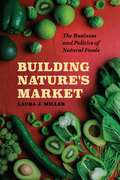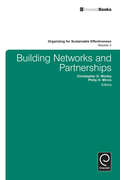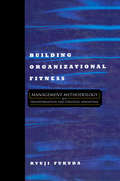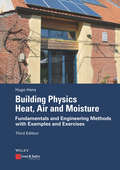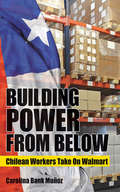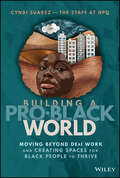- Table View
- List View
Building Nature's Market: The Business and Politics of Natural Foods
by Laura J. MillerFor the first 150 years of their existence, “natural foods” were consumed primarily by body builders, hippies, religious sects, and believers in nature cure. And those consumers were dismissed by the medical establishment and food producers as kooks, faddists, and dangerous quacks. In the 1980s, broader support for natural foods took hold and the past fifteen years have seen an explosion—everything from healthy-eating superstores to mainstream institutions like hospitals, schools, and workplace cafeterias advertising their fresh-from-the-garden ingredients. Building Nature’s Market shows how the meaning of natural foods was transformed as they changed from a culturally marginal, religiously inspired set of ideas and practices valorizing asceticism to a bohemian lifestyle to a mainstream consumer choice. Laura J. Miller argues that the key to understanding this transformation is to recognize the leadership of the natural foods industry. Rather than a simple tale of cooptation by market forces, Miller contends the participation of business interests encouraged the natural foods movement to be guided by a radical skepticism of established cultural authority. She challenges assumptions that private enterprise is always aligned with social elites, instead arguing that profit-minded entities can make common cause with and even lead citizens in advocating for broad-based social and cultural change.
Building Nature's Market: The Business and Politics of Natural Foods
by Laura J. MillerFor the first 150 years of their existence, “natural foods” were consumed primarily by body builders, hippies, religious sects, and believers in nature cure. And those consumers were dismissed by the medical establishment and food producers as kooks, faddists, and dangerous quacks. In the 1980s, broader support for natural foods took hold and the past fifteen years have seen an explosion—everything from healthy-eating superstores to mainstream institutions like hospitals, schools, and workplace cafeterias advertising their fresh-from-the-garden ingredients. Building Nature’s Market shows how the meaning of natural foods was transformed as they changed from a culturally marginal, religiously inspired set of ideas and practices valorizing asceticism to a bohemian lifestyle to a mainstream consumer choice. Laura J. Miller argues that the key to understanding this transformation is to recognize the leadership of the natural foods industry. Rather than a simple tale of cooptation by market forces, Miller contends the participation of business interests encouraged the natural foods movement to be guided by a radical skepticism of established cultural authority. She challenges assumptions that private enterprise is always aligned with social elites, instead arguing that profit-minded entities can make common cause with and even lead citizens in advocating for broad-based social and cultural change.
Building Nature's Market: The Business and Politics of Natural Foods
by Laura J. MillerFor the first 150 years of their existence, “natural foods” were consumed primarily by body builders, hippies, religious sects, and believers in nature cure. And those consumers were dismissed by the medical establishment and food producers as kooks, faddists, and dangerous quacks. In the 1980s, broader support for natural foods took hold and the past fifteen years have seen an explosion—everything from healthy-eating superstores to mainstream institutions like hospitals, schools, and workplace cafeterias advertising their fresh-from-the-garden ingredients. Building Nature’s Market shows how the meaning of natural foods was transformed as they changed from a culturally marginal, religiously inspired set of ideas and practices valorizing asceticism to a bohemian lifestyle to a mainstream consumer choice. Laura J. Miller argues that the key to understanding this transformation is to recognize the leadership of the natural foods industry. Rather than a simple tale of cooptation by market forces, Miller contends the participation of business interests encouraged the natural foods movement to be guided by a radical skepticism of established cultural authority. She challenges assumptions that private enterprise is always aligned with social elites, instead arguing that profit-minded entities can make common cause with and even lead citizens in advocating for broad-based social and cultural change.
Building Network Capabilities in Turbulent Competitive Environments: Business Success Stories from the BRICs
by Paul Hong YoungWon ParkBrazil, Russia, India, and China (BRIC) are among the largest and fastest-growing economies in the world. The enormous size of the customer base in these emerging markets is the strategic concern of global business firms. Successful market performance in these markets requires sound understanding of dynamic environmental factors and timely investme
Building Network Capabilities in Turbulent Competitive Environments: Practices of Global Firms from Korea and Japan
by Young Won Park Paul HongSince the start of the recent financial crisis, as most global firms struggle to remain competitive, an increasing number of Korean and Japanese firms have experienced an amazing rate of growth and expansion. Although academic researchers and business leaders in the United States, China, Brazil, India, and Europe seek out the secrets to these busin
Building Networks and Partnerships (Organizing for Sustainable Effectiveness #3)
by Philip H. Mirvis Abraham B. ShaniOrganizing for Sustainable Effectiveness highlights research and practice aimed at understanding how organizations and more inclusive systems of actors develop a continuous, unfaltering focus on sustainability. It will examine how they organize to achieve expanded purposes, the associated changes in purpose and governance, relationships among various stakeholders, boundaries between organizations and other elements of the environment in which they operate, organizational systems and processes, leadership, competencies and capabilities. Thus 'sustainability' is seen as entailing a continuous dynamic adaptive process in people, organizations and systems, striving to be as proactive as possible, moving 'upstream' in improving and developing organizational processes and issues.
Building New Bridges Between Business and Society: Recent Research and New Cases in CSR, Sustainability, Ethics and Governance (CSR, Sustainability, Ethics & Governance)
by Hualiang Lu René Schmidpeter Nicholas Capaldi Liangrong ZuThis book provides a comprehensive understanding of the linkages between business and society by addressing key issues in corporate social responsibility (CSR), sustainability, ethics and governance. Thanks to the different visions and perspectives offered by a global group of authors with a broad range of expertise, the book offers a full spectrum of theoretical and practical approaches. Further, it combines the latest theoretical thinking with reviews of frameworks, cases and best practices from various industries and nations. In particular, the book offers a historical perspective on the origins of CSR and discusses CSR in relation to sustainability and management, with a special focus on CSR in Asia.
Building Nonprofit Capacity: A Guide to Managing Change Through Organizational Lifecycles
by John Brothers Anne ShermanPraise for Building Nonprofit Capacity "A central question for leadership is to identify where, and when, to focus organizational energy, and that is where Brothers and Sherman's book comes in. Changing organizations is never easy, which is why managers need the right set of maps and tools—like this one." Jon Pratt, executive director, Minnesota Council of Nonprofits "Anyone running a nonprofit organization, no matter how large or small, would benefit from reading this book. It's chock-full of useful information about managing change." Eric Nee, managing editor, Stanford Social Innovation Review "Nonprofit leaders need tools to help them manage better, engage communities, collaborate, and have greater impact. Building Nonprofit Capacity is a great tool and a useful reference for organizations that are seeking to make a greater and more sustainable difference." Paul Schmitz, CEO, Public Allies "Brothers and Sherman expertly braid together complementary organizational lifecycle frameworks—and add their own wide-ranging expertise and experience—to bring practitioners and executives this comprehensive, relevant, and honest book about the organizational quest to become ever better." Jeanne Bell, CEO, CompassPoint Nonprofit Services "Whether you are building a start-up, bringing an organization to scale, managing an established group toward excellence, or shepherding a nonprofit at risk of decline, this book should be required reading for every nonprofit executive director." Richard R. Buery, Jr., president and CEO, The Children's Aid Society "There are a lot of nonprofit management books out there. What makes Brothers and Sherman's book different and so important and worthwhile is that they have combined a number of models, theories, and practices and shaped them into a few essential processes that can be used by organizations both large and small." Doug Bauer, executive director, The Clark Foundation
Building Nonprofit Capacity: A Guide to Managing Change Through Organizational Lifecycles
by John Brothers Anne ShermanPraise for Building Nonprofit Capacity "A central question for leadership is to identify where, and when, to focus organizational energy, and that is where Brothers and Sherman's book comes in. Changing organizations is never easy, which is why managers need the right set of maps and tools—like this one." Jon Pratt, executive director, Minnesota Council of Nonprofits "Anyone running a nonprofit organization, no matter how large or small, would benefit from reading this book. It's chock-full of useful information about managing change." Eric Nee, managing editor, Stanford Social Innovation Review "Nonprofit leaders need tools to help them manage better, engage communities, collaborate, and have greater impact. Building Nonprofit Capacity is a great tool and a useful reference for organizations that are seeking to make a greater and more sustainable difference." Paul Schmitz, CEO, Public Allies "Brothers and Sherman expertly braid together complementary organizational lifecycle frameworks—and add their own wide-ranging expertise and experience—to bring practitioners and executives this comprehensive, relevant, and honest book about the organizational quest to become ever better." Jeanne Bell, CEO, CompassPoint Nonprofit Services "Whether you are building a start-up, bringing an organization to scale, managing an established group toward excellence, or shepherding a nonprofit at risk of decline, this book should be required reading for every nonprofit executive director." Richard R. Buery, Jr., president and CEO, The Children's Aid Society "There are a lot of nonprofit management books out there. What makes Brothers and Sherman's book different and so important and worthwhile is that they have combined a number of models, theories, and practices and shaped them into a few essential processes that can be used by organizations both large and small." Doug Bauer, executive director, The Clark Foundation
Building Organizational Fitness: Management Methodology for Transformation and Strategic Advantage
by Ryuji FukudaUndoubtedly, the most urgent task for companies today is to take a hard look at the future. To remain competitive, management must nurture a strong capability for self development and a strong corporate culture, both of which form part of the foundation for improvement. But simply understanding management techniques doesn't mean you know how to use them. You need the tools and technologies for implementation.In Building Organizational Fitness, Ryuji Fukuda extends the power of his managerial engineering methodology into the context of the top management strategic planning role. Published here for the first time, the author provides information on the evolution of his CEDAC methods for use in strategic planning and implementation. The book introduces several key management technologies and describes their successful application in many Japanese, American and European companies, including: P/O (Policy Objective) Matrix, SEDAC (Structure for Enhancing Daily Activities through Creativity), Window Analysis ( a method for classifying and analyzing problem for a view point of management actions required), and Stockless Production (an approach to reduce work-in-process and lead time in an effective and easy-to-understand manner).
Building Organizational Fitness: Management Methodology for Transformation and Strategic Advantage
by Ryuji FukudaUndoubtedly, the most urgent task for companies today is to take a hard look at the future. To remain competitive, management must nurture a strong capability for self development and a strong corporate culture, both of which form part of the foundation for improvement. But simply understanding management techniques doesn't mean you know how to use them. You need the tools and technologies for implementation.In Building Organizational Fitness, Ryuji Fukuda extends the power of his managerial engineering methodology into the context of the top management strategic planning role. Published here for the first time, the author provides information on the evolution of his CEDAC methods for use in strategic planning and implementation. The book introduces several key management technologies and describes their successful application in many Japanese, American and European companies, including: P/O (Policy Objective) Matrix, SEDAC (Structure for Enhancing Daily Activities through Creativity), Window Analysis ( a method for classifying and analyzing problem for a view point of management actions required), and Stockless Production (an approach to reduce work-in-process and lead time in an effective and easy-to-understand manner).
Building Organizational Intelligence: A Knowledge Management Primer
by Jay Liebowitz"Sharing knowledge is power." If ever there were a field to which this applies, it is the knowledge management industry. And in today's highly-competitive, fast-paced business world, corporations, businesses and organizations in both the public and private sectors are constantly searching for new cutting-edge methods and techniques for creating, storing, capturing, managing, organizing, distributing, combining, and retrieving knowledge. But the task of accomplishing such functions is not as simple as it sounds. Jay Liebowitz's Building Organizational Intelligence: A Knowledge Management Primer gives executives, managers, systems analysts, and other knowledge-management professionals the competitive edge they need in achieving that task. In a concise and easy-to-read format, the book describes the concepts, techniques, methodologies, and tools associated with those functions, and includes mini-case studies and vignettes of how industry is developing and applying these functions towards building organizational intelligence.What's more, the book is packaged with a limited functionality version of "WisdomBuilder," the first in a family of knowledge-management tools that provide a fully integrated solution to the information management and analysis dilemma. Able to run under Windows 95, 98 and NT, "WisdomBuilder" solves the information overload problem by reducing the time and cost of extracting information and other research knowledge from disorganized repositories of heterogeneous data.
Building Organizational Intelligence: A Knowledge Management Primer
by Jay Liebowitz"Sharing knowledge is power." If ever there were a field to which this applies, it is the knowledge management industry. And in today's highly-competitive, fast-paced business world, corporations, businesses and organizations in both the public and private sectors are constantly searching for new cutting-edge methods and techniques for creating, storing, capturing, managing, organizing, distributing, combining, and retrieving knowledge. But the task of accomplishing such functions is not as simple as it sounds. Jay Liebowitz's Building Organizational Intelligence: A Knowledge Management Primer gives executives, managers, systems analysts, and other knowledge-management professionals the competitive edge they need in achieving that task. In a concise and easy-to-read format, the book describes the concepts, techniques, methodologies, and tools associated with those functions, and includes mini-case studies and vignettes of how industry is developing and applying these functions towards building organizational intelligence.What's more, the book is packaged with a limited functionality version of "WisdomBuilder," the first in a family of knowledge-management tools that provide a fully integrated solution to the information management and analysis dilemma. Able to run under Windows 95, 98 and NT, "WisdomBuilder" solves the information overload problem by reducing the time and cost of extracting information and other research knowledge from disorganized repositories of heterogeneous data.
Building People: Sunday Emails from a Chairman
by Mun Leong LiewEavesdrop on a top business leader to learn the secrets of great leadership Building People provides a glimpse into the mind of one of Asia’s keenest and most effective business leaders. Before becoming Chairman of Changi Airport Group and Surbana Jurong, author Mun Leong Liew was named Best CEO in Singapore, Best CEO in Asia, CEO of the Year, Outstanding CEO of the Year, and more—but his successes are not based strictly upon the numbers. This book reveals the personal and professional philosophy behind this extraordinarily effective leader, in the context of frank and insightful emails to his staff. Touching on everything from honour and potential to training and mentorship, these messages paint a clear picture of the difference between good and great leadership. Effective leaders build companies, but legendary leaders build people—by strengthening the heart of your organisation, you enable robust growth and dynamic stability from the inside out. These emails go beyond mere public relations to lay open the true nature of a man who is honestly, deeply committed to his job, his responsibility, his organisation, and most of all, his people. Learn why work-life balance is not a zero-sum game Discover what pragmatism and commitment truly mean in business Realise the importance of good partnerships and unsung heroes Manage change effectively and employ it wisely for sustainable success By eavesdropping on a leader’s communications with the people he serves, you get a real sense of the man behind the success. Great leadership is rooted in a philosophy of “building up” instead of tearing down, and motivated by the sincere belief that we bring our own purpose into everything we do. Building People brings great leadership to life, and inspires action over theory through the insights of Mun Leong Liew.
Building People: Sunday Emails from a Chairman
by Mun Leong LiewEavesdrop on a top business leader to learn the secrets of great leadership Building People provides a glimpse into the mind of one of Asia’s keenest and most effective business leaders. Before becoming Chairman of Changi Airport Group and Surbana Jurong, author Mun Leong Liew was named Best CEO in Singapore, Best CEO in Asia, CEO of the Year, Outstanding CEO of the Year, and more—but his successes are not based strictly upon the numbers. This book reveals the personal and professional philosophy behind this extraordinarily effective leader, in the context of frank and insightful emails to his staff. Touching on everything from honour and potential to training and mentorship, these messages paint a clear picture of the difference between good and great leadership. Effective leaders build companies, but legendary leaders build people—by strengthening the heart of your organisation, you enable robust growth and dynamic stability from the inside out. These emails go beyond mere public relations to lay open the true nature of a man who is honestly, deeply committed to his job, his responsibility, his organisation, and most of all, his people. Learn why work-life balance is not a zero-sum game Discover what pragmatism and commitment truly mean in business Realise the importance of good partnerships and unsung heroes Manage change effectively and employ it wisely for sustainable success By eavesdropping on a leader’s communications with the people he serves, you get a real sense of the man behind the success. Great leadership is rooted in a philosophy of “building up” instead of tearing down, and motivated by the sincere belief that we bring our own purpose into everything we do. Building People brings great leadership to life, and inspires action over theory through the insights of Mun Leong Liew.
Building Performance Evaluation: From Delivery Process to Life Cycle Phases
by Wolfgang F.E. Preiser Andrea E. Hardy Ulrich SchrammThe main aim of this book is to present an intriguing retrospective of Building Performance Evaluation (BPE) as it evolved from Post-Occupancy Evaluation (POE) over the past 25 years. On one hand, this is done by updating original authors' chapter content of Building Evaluation, the first edition published in 1989. That, in turn, is augmented by an orientation toward current and future practice on the other, including new authors who are engaged in ongoing, cutting edge projects. Therefore, individual, methodology oriented chapters covering the fundamental principles of POE and BPE go along with major thematic chapters, topics of which like sustainability or integration of new technologies are addressed in a diversity of case studies from around the globe. Research, methodologies, and framework of POEs continue to evolve. POEs are one step, on the larger scale of BPE, in understanding how buildings function after they are occupied. This resource helps architects, building owners, and facility managers understand the implications and reactions to the facilities that they designed, built and/or commissioned. By considering the whole process from conception to future uses of the building, there can be a more holistic approach to the planning, programming, design, construction, occupancy, and future adaptability of the structure. This book is dedicated to first editor Wolfgang F. E. Preiser who passed away during the process of editing and reviewing chapters of this volume.
Building Physics - Heat, Air and Moisture: Fundamentals and Engineering Methods with Examples and Exercises
by Hugo S. HensBad experiences with construction quality, the energy crises of 1973 and 1979, complaints about "sick buildings", thermal, acoustical, visual and olfactory discomfort, the need for good air quality, the move towards more sustainability - all these have accelerated the development of a field that, for a long time, was hardly more than an academic exercise: building physics (in English speaking countries sometimes referred to as building science). The discipline embraces domains such as heat and mass transfer, building acoustics, lighting, indoor environmental quality and energy efficiency. In some countries, fire safety is also included. Through the application of physical knowledge and its combination with information coming from other disciplines, the field helps to understand the physical phenomena governing building parts, building envelope, whole buildings and built environment performance, although for the last the wording "urban physics" is used. Today, building physics has become a key player on the road to a performance based building design. The book deals with the description, analysis and modeling of heat, air and moisture transport in building assemblies and whole buildings with main emphasis on the building engineering applications, including examples. The physical transport processes determine the performance of the building envelope and may influence the serviceability of the structure and the whole building. Compared to the second edition, in this third edition the text has partially been revised and extended.
Building Physics - Heat, Air and Moisture: Fundamentals and Engineering Methods with Examples and Exercises
by Hugo S. HensBad experiences with construction quality, the energy crises of 1973 and 1979, complaints about "sick buildings", thermal, acoustical, visual and olfactory discomfort, the need for good air quality, the move towards more sustainability - all these have accelerated the development of a field that, for a long time, was hardly more than an academic exercise: building physics (in English speaking countries sometimes referred to as building science). The discipline embraces domains such as heat and mass transfer, building acoustics, lighting, indoor environmental quality and energy efficiency. In some countries, fire safety is also included. Through the application of physical knowledge and its combination with information coming from other disciplines, the field helps to understand the physical phenomena governing building parts, building envelope, whole buildings and built environment performance, although for the last the wording "urban physics" is used. Today, building physics has become a key player on the road to a performance based building design. The book deals with the description, analysis and modeling of heat, air and moisture transport in building assemblies and whole buildings with main emphasis on the building engineering applications, including examples. The physical transport processes determine the performance of the building envelope and may influence the serviceability of the structure and the whole building. Compared to the second edition, in this third edition the text has partially been revised and extended.
Building Physics - Heat, Air and Moisture: Fundamentals, Engineering Methods, Material Properties and Exercises
by Hugo S. HensBad experiences with construction quality, the energy crises of 1973 and 1979, complaints about "sick buildings", thermal, acoustical, visual and olfactory discomfort, the need for good air quality, the move towards energy efficiency, decarbonization and sustainability ? all these have accelerated the development of a discipline that, for a long time, was hardly more than an academic exercise: building physics. The discipline embraces domains such as heat and mass transfer, building acoustics, lighting, indoor environmental quality, energy efficiency, and, in some countries, fire safety. Through the application of physical knowledge and its combination with information coming from other disciplines, building physics helps to under-stand the physical phenomena governing building parts, building envelope, whole building and built environment performance ? called urban physics. Today, building physics has be-come a key player on the road to highly performing new buildings and renovations. This book deals with heat, air and moisture transport in building parts or assemblies and whole buildings with emphasis on the building engineering applications. Compared to the third edition, this fourth edition has been expanded in chapter 1 to include the physical determination of the thermal conductivity of materials, together with an in-depth discussion of all the effects of thicker insulation layers. In chapter 2, additional information has been added on wind pressure and the evaluation of condensation inside the building com-ponents, while a new chapter 4 on material properties has been included. The whole book, including the figures, has been revised and restructured where necessary.
Building Physics - Heat, Air and Moisture: Fundamentals, Engineering Methods, Material Properties and Exercises
by Hugo S. HensBad experiences with construction quality, the energy crises of 1973 and 1979, complaints about "sick buildings", thermal, acoustical, visual and olfactory discomfort, the need for good air quality, the move towards energy efficiency, decarbonization and sustainability ? all these have accelerated the development of a discipline that, for a long time, was hardly more than an academic exercise: building physics. The discipline embraces domains such as heat and mass transfer, building acoustics, lighting, indoor environmental quality, energy efficiency, and, in some countries, fire safety. Through the application of physical knowledge and its combination with information coming from other disciplines, building physics helps to under-stand the physical phenomena governing building parts, building envelope, whole building and built environment performance ? called urban physics. Today, building physics has be-come a key player on the road to highly performing new buildings and renovations. This book deals with heat, air and moisture transport in building parts or assemblies and whole buildings with emphasis on the building engineering applications. Compared to the third edition, this fourth edition has been expanded in chapter 1 to include the physical determination of the thermal conductivity of materials, together with an in-depth discussion of all the effects of thicker insulation layers. In chapter 2, additional information has been added on wind pressure and the evaluation of condensation inside the building com-ponents, while a new chapter 4 on material properties has been included. The whole book, including the figures, has been revised and restructured where necessary.
Building Power from Below: Chilean Workers Take On Walmart
by Carolina Bank MuñozA story that involves as its main players "workers" and "Walmart" does not usually have a happy ending for labor, so the counternarrative offered by Building Power from Below is must reading for activists and union personnel as well as scholars. In 2008 Walmart acquired a controlling share in a large supermarket chain in Santiago, Chile. As part of the deal Walmart had to accept the unions that were already in place. Since then, Chilean retail and warehouse workers have done something that has seemed impossible for labor in the United States: they have organized even more successful unions and negotiated unprecedented contracts with Walmart.In Building Power from Below, Carolina Bank Muñoz attributes Chilean workers’ success in challenging the world’s largest corporation to their organizations’ commitment to union democracy and building strategic capacity. Chilean workers have spent years building grassroots organizations committed to principles of union democracy. Retail workers’ unions have less structural power, but have significant associational and symbolic power. Their most notable successes have been in fighting for respect and dignity on the job. Warehouse workers by contrast have substantial structural power and have achieved significant economic gains. While the model in Chile cannot necessarily be reproduced in different countries, we can gain insights from the Chilean workers’ approaches, tactics, and strategies.
Building A Pro-Black World: Moving Beyond DE&I Work and Creating Spaces for Black People to Thrive
by Nonprofit QuarterlyLearn to create a nonprofit organization and society in which Black people can thrive In Building A Pro-Black World: A Guide To Creating True Equity in The Workplace and In Life, a team of dedicated nonprofit leaders delivers a timely roadmap to building pro-Black nonprofit organizations. Refreshingly moving the conversation beyond stale DEI cliches, editors Cyndi Suarez and the NPQ staff have included works from leading racial justice voices that show you how to create an environment—and society—in which Black people can thrive. You’ll also learn how building such a world will benefit all of society, from the most marginalized to the least. The book explains how to shift from simply critiquing white supremacist culture and calling out anti-Blackness to actively designing for pro-Blackness. It offers you: Incisive and engaging work from leading voices in racial justice, Cyndi Suarez, Dax-Devlon Ross, Liz Derias, Kad Smith, and Isabelle Moses Explorations of topics ranging from restorative leadership strategies for staff wellbeing to Black politics and policymaking Discussions of new language for pro-Black social change, racial equity in healthcare and health communications, and antiracist succession planning A can’t-miss resource for civil society and nonprofit leaders, including directors, executives, grant makers, philanthropic donors, and social movement leaders, Building Pro-Black World will also benefit communicators, organizers, and consultants who work with nonprofit organizations.
Building A Pro-Black World: Moving Beyond DE&I Work and Creating Spaces for Black People to Thrive
by Nonprofit QuarterlyLearn to create a nonprofit organization and society in which Black people can thrive In Building A Pro-Black World: A Guide To Creating True Equity in The Workplace and In Life, a team of dedicated nonprofit leaders delivers a timely roadmap to building pro-Black nonprofit organizations. Refreshingly moving the conversation beyond stale DEI cliches, editors Cyndi Suarez and the NPQ staff have included works from leading racial justice voices that show you how to create an environment—and society—in which Black people can thrive. You’ll also learn how building such a world will benefit all of society, from the most marginalized to the least. The book explains how to shift from simply critiquing white supremacist culture and calling out anti-Blackness to actively designing for pro-Blackness. It offers you: Incisive and engaging work from leading voices in racial justice, Cyndi Suarez, Dax-Devlon Ross, Liz Derias, Kad Smith, and Isabelle Moses Explorations of topics ranging from restorative leadership strategies for staff wellbeing to Black politics and policymaking Discussions of new language for pro-Black social change, racial equity in healthcare and health communications, and antiracist succession planning A can’t-miss resource for civil society and nonprofit leaders, including directors, executives, grant makers, philanthropic donors, and social movement leaders, Building Pro-Black World will also benefit communicators, organizers, and consultants who work with nonprofit organizations.
Building Procurement (Building And Surveying Ser.)
by Alan TurnerAims to explain in simple terms how the construction constituents of client, consultants and contractors fit together, as well as providing practical guidance on the decisions necessary to choose a particular procurement route.
